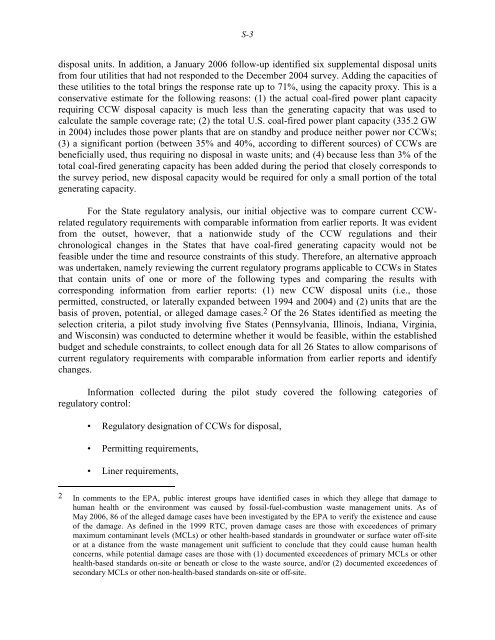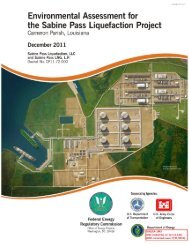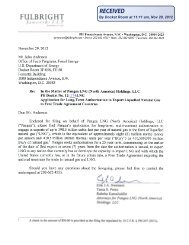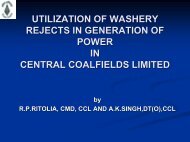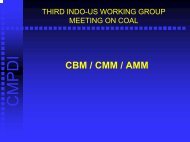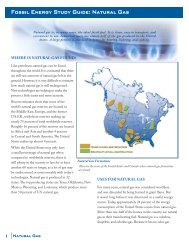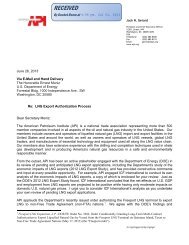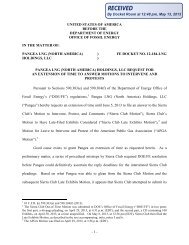Coal Combustion Waste Management at - DOE - Fossil Energy ...
Coal Combustion Waste Management at - DOE - Fossil Energy ...
Coal Combustion Waste Management at - DOE - Fossil Energy ...
Create successful ePaper yourself
Turn your PDF publications into a flip-book with our unique Google optimized e-Paper software.
S-3<br />
disposal units. In addition, a January 2006 follow-up identified six supplemental disposal units<br />
from four utilities th<strong>at</strong> had not responded to the December 2004 survey. Adding the capacities of<br />
these utilities to the total brings the response r<strong>at</strong>e up to 71%, using the capacity proxy. This is a<br />
conserv<strong>at</strong>ive estim<strong>at</strong>e for the following reasons: (1) the actual coal-fired power plant capacity<br />
requiring CCW disposal capacity is much less than the gener<strong>at</strong>ing capacity th<strong>at</strong> was used to<br />
calcul<strong>at</strong>e the sample coverage r<strong>at</strong>e; (2) the total U.S. coal-fired power plant capacity (335.2 GW<br />
in 2004) includes those power plants th<strong>at</strong> are on standby and produce neither power nor CCWs;<br />
(3) a significant portion (between 35% and 40%, according to different sources) of CCWs are<br />
beneficially used, thus requiring no disposal in waste units; and (4) because less than 3% of the<br />
total coal-fired gener<strong>at</strong>ing capacity has been added during the period th<strong>at</strong> closely corresponds to<br />
the survey period, new disposal capacity would be required for only a small portion of the total<br />
gener<strong>at</strong>ing capacity.<br />
For the St<strong>at</strong>e regul<strong>at</strong>ory analysis, our initial objective was to compare current CCWrel<strong>at</strong>ed<br />
regul<strong>at</strong>ory requirements with comparable inform<strong>at</strong>ion from earlier reports. It was evident<br />
from the outset, however, th<strong>at</strong> a n<strong>at</strong>ionwide study of the CCW regul<strong>at</strong>ions and their<br />
chronological changes in the St<strong>at</strong>es th<strong>at</strong> have coal-fired gener<strong>at</strong>ing capacity would not be<br />
feasible under the time and resource constraints of this study. Therefore, an altern<strong>at</strong>ive approach<br />
was undertaken, namely reviewing the current regul<strong>at</strong>ory programs applicable to CCWs in St<strong>at</strong>es<br />
th<strong>at</strong> contain units of one or more of the following types and comparing the results with<br />
corresponding inform<strong>at</strong>ion from earlier reports: (1) new CCW disposal units (i.e., those<br />
permitted, constructed, or l<strong>at</strong>erally expanded between 1994 and 2004) and (2) units th<strong>at</strong> are the<br />
basis of proven, potential, or alleged damage cases. 2 Of the 26 St<strong>at</strong>es identified as meeting the<br />
selection criteria, a pilot study involving five St<strong>at</strong>es (Pennsylvania, Illinois, Indiana, Virginia,<br />
and Wisconsin) was conducted to determine whether it would be feasible, within the established<br />
budget and schedule constraints, to collect enough d<strong>at</strong>a for all 26 St<strong>at</strong>es to allow comparisons of<br />
current regul<strong>at</strong>ory requirements with comparable inform<strong>at</strong>ion from earlier reports and identify<br />
changes.<br />
Inform<strong>at</strong>ion collected during the pilot study covered the following c<strong>at</strong>egories of<br />
regul<strong>at</strong>ory control:<br />
Regul<strong>at</strong>ory design<strong>at</strong>ion of CCWs for disposal,<br />
Permitting requirements,<br />
Liner requirements,<br />
2 In comments to the EPA, public interest groups have identified cases in which they allege th<strong>at</strong> damage to<br />
human health or the environment was caused by fossil-fuel-combustion waste management units. As of<br />
May 2006, 86 of the alleged damage cases have been investig<strong>at</strong>ed by the EPA to verify the existence and cause<br />
of the damage. As defined in the 1999 RTC, proven damage cases are those with exceedences of primary<br />
maximum contaminant levels (MCLs) or other health-based standards in groundw<strong>at</strong>er or surface w<strong>at</strong>er off-site<br />
or <strong>at</strong> a distance from the waste management unit sufficient to conclude th<strong>at</strong> they could cause human health<br />
concerns, while potential damage cases are those with (1) documented exceedences of primary MCLs or other<br />
health-based standards on-site or bene<strong>at</strong>h or close to the waste source, and/or (2) documented exceedences of<br />
secondary MCLs or other non-health-based standards on-site or off-site.


